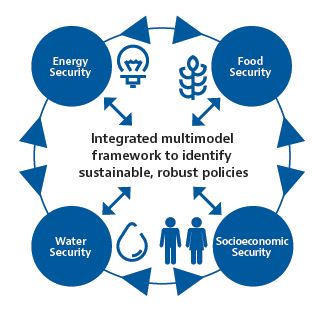Robust land-use management
Providing policymakers with robust guidance on land-use management is becoming increasingly difficult under the uncertainties of climate change. IIASA researchers have now updated the institute’s large-scale land-use model to better incorporate these uncertainties, and used it to provide the Ukrainian government recommendations for sustainable management of agriculture.
The IIASA Global Biosphere Management Model (GLOBIOM) is used to analyze the competition for land between agriculture, forestry, and bioenergy. While it was originally developed as a global model, GLOBIOM can be adjusted to analyze strategies for sustainable development on national scales as well.
Agriculture currently generates about 10% of Ukrainian GDP and national food security largely relies on small, often family-owned farms, which meet domestic demand for major crops despite the fact that they are neither efficient nor profitable. At the same time, large agri-businesses produce more profitable crops and take advantage of the economy of scale, exporting most of their produced food abroad.
To help policymakers tackle these and other problems, researchers from the Advanced Systems Analysis Program in collaboration with the Ecosystems Services and Management program, working as part of the project Integrated Modeling of Robust Solutions for Food, Energy, and Water Security Management, have down-scaled GLOBIOM to apply it to Ukraine [1]. This can provide detailed, national-level advice that is consistent with global targets, and IIASA work has now been used as input for Ukraine’s Strategy of Agriculture and Rural Development, prepared with the support of the UN Food and Agriculture Organization.
Recommendations for policymakers must be robust in the face of uncertainties: a policy that only works in an entirely predictable world is useless.
To ensure that GLOBIOM provides guidance that is robust under all eventualities, IIASA researchers developed a stochastic version of the model that incorporates uncertainties and risks related to weather variability and climate change. The team has also improved the way GLOBIOM models the vulnerability of global supply chains to shocks such as natural disasters or price spikes, by including risks of low-probability, high-impact events. Their analysis showed clear benefits of the stochastic technique over the commonly used deterministic approach [2].
References
[1] Borodina O, Kyryzyuk S, Yarovyi V, Ermoliev Y, & Ermolieva T (2016). Modeling local land uses under the global change. Economics and Forecasting 1: 117-128.
[2] Ermolieva T, Havlík P, Ermoliev Y, Mosnier A, Obersteiner M, Leclère D, Khabarov N, Valin H, et al. (2016). Integrated Management of Land Use Systems under Systemic Risks and Security Targets: A Stochastic Global Biosphere Management Model. Journal of Agricultural Economics 67 (3): 584-601.
Collaborators
- National Academy of Sciences, Ukraine
Further information
IIASA impact sheet: Robust food, energy, water, and land management

